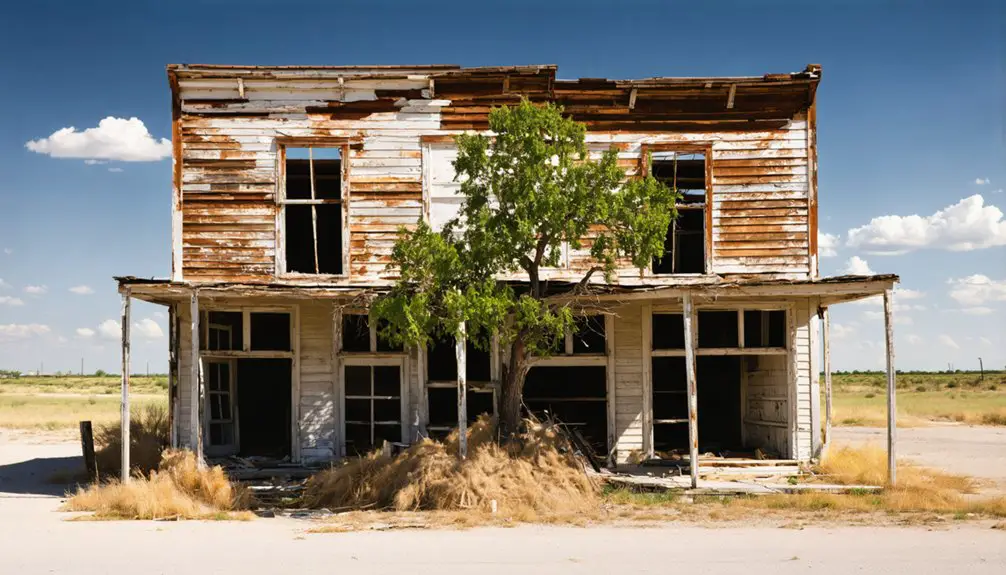You’ll find Arden in northeastern Irion County, Texas, where John and Katie Arden established a thriving ranching community in 1885. The town grew around Rocky Creek, boasting a post office by 1890 and a brick schoolhouse by 1916. Severe droughts in the early 20th century devastated local agriculture, forcing families to abandon their homes. Today, only scattered ruins and foundations remain of this once-bustling settlement, but its story reveals much about West Texas’s pioneer spirit.
Key Takeaways
- Established in 1885 in Irion County, Texas, Arden thrived as a ranching community before severe droughts led to its abandonment.
- The post office closed in 1942 and the school in 1947, marking significant milestones in Arden’s decline into a ghost town.
- Environmental challenges, including water scarcity and aquifer depletion, forced many families to abandon their properties and seek opportunities elsewhere.
- Originally centered around sheep ranching, the community featured a brick schoolhouse, post office, and cemetery before its eventual decline.
- Today, Arden consists of scattered ruins, deteriorating structures, and abandoned buildings, with the landscape reverting to rural pastureland.
The Founding of a Ranching Community
While westward expansion swept across Texas in the late 19th century, Arden emerged as a promising ranching settlement in 1885 along Rocky Creek in northeastern Irion County.
Settlement patterns followed the typical homesteading model of the era, with pioneers claiming land under federal laws that encouraged western migration. You’ll find that the founders chose this location strategically – Rocky Creek provided essential water access for both livestock and settlers in the arid terrain. Like many other settlements that became ghost towns in Texas, Arden’s fate would ultimately be shaped by economic forces beyond its residents’ control.
The community was named after John and Katie Arden, who were among the first settlers to establish roots in the area.
The remote setting shaped early ranching practices, as residents adapted to managing cattle in the challenging Texas landscape.
Despite its isolation, the community’s position proved ideal for grazing operations, and the settlement grew into a close-knit ranching society where every family played a crucial role in building this frontier outpost.
Legacy of John and Katie Arden
The history of Arden, Texas centers on its namesakes, John and Katie Arden, who settled their land claim in 1885.
John’s influence as a sheep raiser since 1876 shaped the Arden origins and established the community’s ranching heritage, while Katie’s role in managing the homestead proved essential to their success. Like the early days of Bosque County, they faced the challenges of frontier settlement. Local residents gathered for spiritual fellowship at camp meetings held in the Grove on Rocky Creek.
The Ardens laid Arden’s foundation through John’s sheep ranching expertise and Katie’s vital homestead management, creating a lasting agricultural legacy.
You’ll find their legacy woven into every aspect of the settlement’s development. Together, they fostered community resilience through the establishment of a post office in 1890 and a school in 1892.
Though the town eventually declined, with the post office closing in 1942 and the school in 1947, the Ardens’ pioneering spirit lives on.
Their story of determination and grit is now preserved through historical markers, cementing their place in West Texas history.
Life Along Rocky Creek
Life along Rocky Creek revolved around a tight-knit ranching community, where sheep raising formed the economic backbone since John Arden’s initial settlement.
You’d find daily routines dictated by seasonal rhythms – from lambing to shearing – as ranchers and small homesteaders worked the semi-arid land after 1900.
Community dynamics centered on shared spaces where faith and social life intertwined. The area’s first settler, John Arden, established roots here until his death in 1881.
You’d witness Baptist, Methodist, and Church of Christ congregations gathering at the schoolhouse for services, while “The Grove” hosted vibrant camp meetings that strengthened social bonds.
The creek itself played a crucial role, providing essential water for livestock and households.
However, recurring droughts through the early 20th century gradually weakened the community’s economic foundation, leading to hardships that would ultimately challenge the settlement’s sustainability.
The Rise of Community Institutions
As Arden’s population grew in the late 1800s, essential community institutions emerged to serve the settlement’s expanding needs.
You’ll find that community development started with the establishment of a post office in 1890, followed by a school in 1892. Joe Funk’s generous land donation in 1903 provided space for both a school and cemetery, marking a significant step in institutional evolution.
The local schoolhouse became a hub of activity, serving not only as an educational facility but also as a shared worship space for Baptist, Church of Christ, and Methodist congregations. The facility’s multi-purpose design was reminiscent of the dense forest region of Ardennes, where communities often shared limited resources.
Like many of the 511 ghost towns across Texas, by 1916, you’d have seen a proud brick schoolhouse replace the original structure, symbolizing Arden’s growth and permanence.
These institutions flourished until environmental and economic challenges of the mid-1900s led to their eventual closure.
Religious and Social Gatherings
Religious life in Arden centered around shared worship spaces, with Baptist, Church of Christ, and Methodist congregations converging at the local schoolhouse for services. This arrangement fostered remarkable community cohesion among the diverse frontier population, with the schoolhouse serving as both an educational and spiritual hub until 1916. Like the historic town of Sweet Home, Arden was established by former slaves seeking religious freedom and community solidarity.
You’ll find these fascinating aspects of Arden’s religious gatherings:
- Camp meetings at “The Grove” near Rocky Creek became spiritual and social highlights, featuring multi-day events of preaching and singing.
- The school, built on Joe Funk’s donated land, hosted both religious services and seasonal celebrations.
- Shared worship practices helped minimize denominational differences, promoting unity and mutual support.
- Religious institutions provided essential social structure and identity for settlers facing frontier challenges.
Economic Changes and Challenges
Arden’s early economic foundation shifted from large-scale ranching operations to smaller homestead settlements as more settlers moved into the region.
You’ll find that severe droughts in the area created significant hardships for these homesteaders, who struggled to maintain profitable farming operations on their modest plots.
The economic strain from these droughts pushed many families to seek opportunities elsewhere, marking the beginning of Arden’s gradual decline.
Like the residents of boom towns Ranger in the early 1900s, many families were forced to relocate in search of better economic opportunities.
Similar to the coal miners of Thurber, residents faced once-a-month paychecks that made it difficult to maintain stable household finances.
Ranching to Homestead Shift
While ranching dominated Arden’s early economy after John Arden’s 1876 settlement, significant changes emerged in the early 1900s as small homesteaders began settling the area.
The shift from large-scale ranching operations to smaller homesteads marked a vital change in Arden’s development, bringing agricultural diversification to the region.
You’ll find these key changes shaped Arden’s landscape:
- Homestead development expanded through land donations, particularly from Joe Funk
- Mixed farming practices emerged alongside traditional animal husbandry
- New settlers introduced diverse crop production to supplement livestock operations
- Community centers formed around schools and post offices to serve the growing population
However, these smaller operations faced considerable challenges, struggling with limited water access and fluctuating commodity prices compared to established ranches.
Drought’s Economic Impact
The severe droughts that struck in the early 20th century dealt a devastating blow to Arden’s shift toward homestead farming. Without adequate water resources, you’d have witnessed widespread crop failures and livestock losses that crippled local agricultural operations.
The lack of drought resilience strategies left farmers and ranchers vulnerable, forcing many to abandon their properties as land values plummeted.
You would’ve seen the cascading effect as declining populations led to business closures and reduced employment opportunities. Economic recovery plans never materialized, and essential services disappeared – the post office closed in 1942, followed by the school in 1947.
The deteriorating infrastructure and lack of economic alternatives transformed Arden from a thriving community into a ghost town, showcasing how environmental pressures can decimate water-dependent rural economies.
Natural Forces and Population Decline

You’ll find that Arden’s ranching community faced severe challenges when droughts in the early 1900s drastically reduced water availability in Rocky Creek.
The limited water supply made it nearly impossible for homesteaders to sustain their livestock and maintain viable ranching operations.
This environmental stress forced many families to abandon their agricultural pursuits, marking the beginning of Arden’s transformation into a ghost town.
Drought’s Impact on Ranching
Throughout Arden’s history, persistent drought episodes devastated the region’s ranching operations, triggering a cascade of economic and demographic decline that would eventually transform this once-thriving agricultural community into a ghost town.
Despite attempts at agricultural adaptation, the semi-arid climate of the Texas High Plains proved unforgiving for ranchers trying to maintain drought resilience.
The drought’s devastating effects on ranching operations included:
- Severe water shortages that decimated cotton yields and forced dramatic reductions in cattle herds
- Rising operational costs as ranchers struggled to secure supplemental feed and water resources
- Widespread soil erosion and pasture degradation that crippled agricultural productivity
- Financial strain that prevented essential infrastructure investments and modernization efforts
These challenges ultimately forced many ranchers to abandon their operations, accelerating Arden’s transformation into a ghost town.
Rocky Creek Water Challenges
While drought severely impacted Arden’s ranching operations, water challenges extended far beyond agricultural concerns, particularly in the Rocky Creek area where both natural forces and population pressures created complex hydrological problems.
You’ll find groundwater depletion becoming increasingly severe in the Carrizo-Wilcox Aquifer, where the “rule of capture” lets landowners pump without limits. This unrestricted extraction threatens existing wells that serve residents and wildlife springs.
Meanwhile, water quality issues plague Rocky Creek itself, with low dissolved oxygen levels endangering aquatic life throughout the Brazos River Basin. Though Rocky Creek Estates‘ drinking water currently meets safety standards, you’re seeing mounting pressure on regional resources as data centers and population growth compete for limited water supplies.
These challenges highlight the delicate balance between development and preservation in Texas’ water-stressed regions.
What Remains Today
Today, Arden stands as a shell of its former self, with only scattered ruins and foundations marking where this once-active Texas community thrived.
As you explore this ghost town along Farm to Market Road 85, you’ll find remnants of structures that tell the story of a bygone era.
- A handful of deteriorating residential houses dot the landscape, though they’re largely uninhabited and falling into disrepair.
- Ghost town relics include original building foundations and footings scattered throughout the area.
- You’ll find no operating businesses or public institutions – just abandoned commercial structures slowly returning to nature.
- The surrounding landscape has reverted to rural pastureland, with Rocky Creek still flowing through this remote corner of Irion County where census records show as few as one resident in recent years.
Historical Significance in West Texas

Arden’s story mirrors the broader challenges of environmental sustainability that many West Texas settlements faced.
The town’s evolution from sheep ranching to diversified homesteading, followed by its eventual decline due to devastating droughts, exemplifies the delicate balance between human ambition and nature’s constraints.
The Texas Historical Commission’s 1979 marker acknowledges Arden’s significance in understanding how rural communities adapted, thrived, and ultimately succumbed to the harsh realities of West Texas life.
Frequently Asked Questions
What Was the Highest Recorded Population of Arden During Its Peak Years?
Through the dusty pages of Arden history, you’ll find population trends peaked at 100 residents in both 1990 and 2000, though the small community never exceeded 150 throughout its documented existence.
Are There Any Remaining Descendants of John and Katie Arden in Texas?
Based on available Arden family history records and archives, you won’t find conclusive proof of living descendants from John and Katie Arden in Texas today, though undocumented relatives may exist.
What Types of Wildlife Were Commonly Found Around Arden’s Rocky Creek?
With over 20 species documented, you’ll find abundant white-tailed deer sightings near Rocky Creek, plus diverse bird species like wild turkeys, hawks, and owls, alongside raccoons, coyotes, and snakes.
Did Any Famous Outlaws or Historical Figures Ever Pass Through Arden?
You won’t find documented outlaw encounters or historical significance related to famous figures in Arden. Records show no evidence of notorious outlaws or notable personalities passing through this remote ranching community.
What Were the Average Land Prices for Homesteads in Early Arden?
You’d have paid around $1.25 per acre for homestead prices in early settlement, though land value varied based on federal graduated pricing scales and Texas-specific headright policies after 1854.
References
- https://www.hmdb.org/m.asp?m=136074
- https://www.ghosttowns.com/states/tx/tx_ghst_twns_sect1345.doc
- https://roadsidethoughts.com/tx/arden-xx-irion-profile.htm
- https://en.wikipedia.org/wiki/List_of_ghost_towns_in_Texas
- https://texashighways.com/culture/history/what-the-heck-is-a-ghost-town/
- https://www.tshaonline.org/handbook/online/articles/hra48
- https://www.texasescapes.com/TexasTowns/Arden-Texas.htm
- https://www.texasescapes.com/TOWNS/Texas_ghost_towns.htm
- https://www.tarleton.edu/the-industrious-historian/2011/01/23/the-gravestone-of-a-ghost-town/
- https://www.bosquechc.org/sites-markers.shtml



